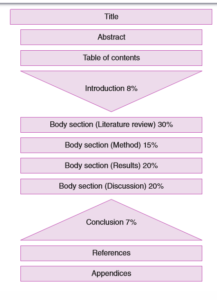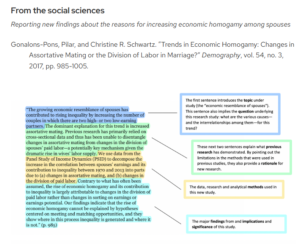Education
Top 7 Tips for Writing Dissertation Sections – Examples Included

Dissertation writing is a challenging, lengthy process that requires dedication, critical thinking, and advanced writing skills. A well-structured dissertation includes certain sections, such as an introduction, literature review, methodology, results, discussion, and conclusion, each section essential for coherently presenting and analysing original research.
Meanwhile, universities require students to finish their dissertations within the prescribed deadline to make them adopt a more disciplined approach. Therefore, understanding each section of the dissertation is essential for students to navigate this process effectively and efficiently.
Here, we will explore the top seven effective tips for writing each section of your dissertation. These insights will guide you as you design and develop your final project, helping you to produce a polished and cohesive piece of academic work.
How to Effectively Write Dissertation Sections – 7 Proven Methods
Clarity and organised structure are essential components in writing a dissertation. However, to attain high academic grades, it’s important to ensure that your research work is not only clear and well-organised but also demonstrates that it is deeply researched and aligned with the objectives of your research.
The University of Bath has outlined exceptional elements of dissertation sections that help in writing a dissertation to maintain structure and clarity. Here is an example picture representing a table that highlights the important steps in a sequence that are required for writing a dissertation section:

Image Source: University of Bath
1. Title
The first step in dissertation writing is to provide a clear and concise title that reflects the focus of your research. Your dissertation title is the first glance to take a positive impression from the readers. It must be definite and self-explanatory. The title of your dissertation or research paper should capture the main idea, giving readers an immediate understanding of your research study.
The Sampoerna University shared some crucial points for crafting the best title that must be considered.
- The title must be short, precise and captivating and explain the prediction of your research work.
- It must convey the research approach and writing tone.
- The research topic title must contain essential keywords that make it simpler for anyone conducting a keyword search to find.
2. Introduction
Writing a captivating introduction is an essential component of your dissertation. Because it determines your objective for what this section needs to achieve. The introduction is the first interaction you will have with your reader after the title. This succinct section demonstrates the objectives of your whole research work. The opening paragraph of the introduction gives your readers the best opportunity to engage them.
Therefore, it’s vital to produce a strong dissertation introduction to:
- Provide contextual information about your work.
- Give readers a thorough understanding of the dissertation’s topic.
- Explain the pain point you plan to investigate.
3. Writing an Abstract
An abstract is a concise summary rather than an introduction of your researched work, typically a paragraph based on (about 6-7 sentences, 150-250 words).
A well-written abstract of your research paper serves multiple goals to achieve:
- An abstract gives readers a quick summary of your research so they can decide whether to read the entire thing,
- This will prepare them to follow the deep insights, arguments, and analyses in the full paper and help them remember important points later.
When writing an abstract, you must follow the supervisor’s specific guidelines, which help you understand what to include and how to organise it. Below is an example to understand the format of writing an abstract as shown in the picture given below:

Image Source: University of Wisconsin – Madison
Abstracts are of two kinds that differ from each other based on their subject discipline. Therefore, you decide to identify which type of abstract you need to include with your research paper.
These two common types are mentioned with examples.
1. Informative Abstract
Informative abstracts are often used to clear the major/main point of the research. You must get the essence of what your report is about, usually in about 200 words. Most informative abstracts also have some key parts in common. However, each of these parts might consist of 1-2 sentences.
The following are the essential parts included in the informative abstract:
- The background
- Aim or research objectives
- Method used
- Findings/results conclusion
Moreover, in both types of abstract, the university supervisor may require other specific information to be included. Always follow any suggestions or feedback from your instructor.
2. Descriptive Abstract
Descriptive abstracts are generally used for humanities and social science papers or psychology essays. They are usually very short (50-100 words).
Most descriptive abstracts have certain key parts in common.
- Background history
- Research objectives
- Relevant interest area/focus of the research paper
- Overview of contents (not always included)
4. Literature Review
A dissertation literature review offers an objective assessment of the sources (literature) you have read and acquired related to your topic. It helps the student to understand the current state of knowledge and address the gaps that can be filled through research. A thorough literature review is a foundation for writing a dissertation. This phase will introduce the importance of examining sources and interpreting data when writing a dissertation project.
Follow the mentioned step to conduct a literature review for your dissertation that helps to fill the gap with your research findings:
- Define a brief about your research scope.
- Create a checklist for your research study by acquiring knowledge from scholarly books, peer-reviewed journals, or articles.
- Critically analyse the author’s suggestions and provide evidence to support your research question.
5. Research Methodology
This section of your dissertation writing flows organically from the literature review. As we gather data for the dissertation, it’s time to compile our research methodologies clearly. Crafting an outline is considered an important step that demonstrates how you will conduct your research.
However, this section explains the techniques you plan to answer your research question. Start by describing the data collection process from surveys, existing databases, or web scraping.
To attain this purpose, consider the following points regarding data analysis:
- In the first half, outline the analytic methods you’ll apply for research, such as qualitative, quantitative or mixed methods.
- Next, address how you preprocess and clean the data that is ready for analysis. At last, evaluate the effectiveness of your model using metrics like accuracy and precision to validate your findings.
6. Result And Discussion
You know you have completed your writing, so before you close the document, wrap up the whole discussion. Remember this is not all about the conclusion but shows the implementation of your work. The results and discussion section showcases your research findings and data interpretation.
Present the data collected during your study, ensuring accuracy and clarity. You can visually represent your key results by using tables, figures, or charts that help the readers grasp data at a glance.
However, your key discussion moves may include,
- Analyse the research question and give concise answers to navigate it properly.
- The implementation of your research must define the contribution of theory in the field.
- Always acknowledge the boundaries of your research study.
- Point out the next frontier and what you can do in future to stretch your work.
7. References
In research work, a reference is the source of information presented by an academic scholar that is not your research. As with academic writing, you must cite your sources in your dissertation. The information you acknowledged in your research paper is listed in a reference list.
Remember that using the phrase “as cited in…” is inappropriate. You must always visit the source as a researcher to verify it for yourself. Even renowned scholars make mistakes when citing. Thus, it’s crucial to avoid repeating someone else’s mistakes. Although it can take a lot of time, this is the correct literature study method.
Conclusion
Writing a dissertation is indeed a challenging journey, but by breaking it down into well-structured sections, students can make the process more manageable and focused. The top tips shared here, paired with practical examples, offer a roadmap to streamline each section, from the introduction to the conclusion. By following these strategies, students can not only strengthen their writing but also ensure that each part of their dissertation contributes meaningfully to their research objectives.
For those seeking extra support, UK-based dissertation writing platforms provide invaluable assistance, particularly with complex formatting and citation requirements. Using these services can help students maintain high standards of academic rigour, allowing them to focus on refining their research and insights. With a structured approach and professional guidance, students can complete their dissertations confidently and advance toward their academic and career goals successfully.
Education
Understanding the “Current Influencer” NYT Crossword Clue

Crossword puzzles have long intrigued minds, but none quite like those in the New York Times. With clever wording and layered meanings, the clues often lead solvers into delightful confusion. One such clue that’s generated buzz recently is: “Current Influencer”. In the context of the NYT Crossword, what does this really mean? Current Influencer” NYT Crossword
Whether you’re a seasoned crossword enthusiast or someone who stumbled upon the clue during a casual attempt at puzzle-solving, this article aims to demystify the clue “Current Influencer” through detailed explanation, relevant associations, and the crossword logic behind its structure.
The Culture of Cryptic Clues in NYT Crosswords
The New York Times crossword puzzles are known for their wit, subtlety, and layered language. Unlike direct puzzles where the answer matches the clue explicitly, many NYT clues use:
Wordplay
Puns
Cultural references
Abbreviations and acronyms
Homonyms
“Current Influencer” fits perfectly into this mold. It seems straightforward but actually operates on a deeper, metaphorical level.
Breaking Down the Clue “Current Influencer”
At first glance, “current influencer” might bring to mind a modern-day social media personality — someone trending on TikTok or Instagram. However, this literal interpretation often leads solvers astray in the NYT puzzle world.
Instead, it’s crucial to dissect both terms in multiple contexts:
Current: Could refer to time (present), electricity (electrical current), water flow (ocean/river current), or even trends.
Influencer: Might imply a person who affects others, or more abstractly, something that causes a shift or movement.
Together, the phrase could point toward something influencing a current or being influenced by current.
Common Answers for “Current Influencer” in Crossword Context
Let’s dive into plausible answers the NYT Crossword might use based on past patterns and solving databases:
AMP: Short for ampere, a unit of electric current — this plays into the pun on “current” (electricity) and “influencer” (something that causes flow).
ELNINO: A weather system known for influencing ocean currents globally.
ION: Electrically charged particle, literally influencing electric current.
TIDE: A natural influencer of ocean currents.
The brilliance of the clue is how the answer hinges on interpreting “current” beyond the modern slang and understanding “influencer” as a causal agent, not necessarily a person.
Why Wordplay Is Crucial to NYT Crossword Solvers
To truly appreciate clues like “Current Influencer,” understanding how constructors play with language is essential. Wordplay is a critical element in NYT crossword construction. Clues are often:
Figurative, not literal
Minimalist in language
Sometimes misleading by design
This turns the crossword into more than a vocabulary test — it becomes a riddle where lateral thinking reigns supreme.
The Rise of Meta Clues and Modern Vocabulary
Over the years, crossword clues have evolved to reflect modern vocabulary. Words like “meme,” “hashtag,” and even “TikTok star” have entered the puzzle lexicon. This evolution means solvers have to stay updated with both traditional knowledge and pop culture.
However, in cases like “Current Influencer,” the clue disguises itself as modern while requiring old-school interpretation. That’s the NYT puzzle’s genius.
Common Solver Mistakes with the “Current Influencer” Clue
Let’s explore where solvers go wrong when facing this clue:
Taking it too literally: Jumping straight to “TikToker” or “YouTuber” ignores the wordplay.
Missing dual meanings: Overlooking “current” as a scientific term.
Overthinking: Searching for complex answers when simple ones like “ION” or “AMP” are more likely.
Understanding this helps you develop the right mindset for future puzzle solving.
The Role of Context in Crossword Solving
One of the key strategies for solving cryptic clues like “Current Influencer” is using surrounding answers. The intersecting words can narrow down possible answers significantly. Here’s how:
Check how many letters the clue demands.
Use existing letters to guess plausible words.
Match definitions based on known word lengths.
Crossword puzzles are rarely about one clue — they’re about how clues connect.
Crossword Culture: How Clues Like This Reflect Broader Trends
The inclusion of clues like “Current Influencer” shows the evolving nature of puzzles. Once limited to Shakespeare and geography, they now span:
Pop culture
Technology
Environmental science
Internet slang
This helps keep the puzzles fresh and engaging across generations.
How to Improve at Solving Clues Like “Current Influencer”
If you’re intrigued by clues like this, here are some tips to get better:
Practice Daily: The more puzzles you solve, the more patterns you recognize.
Expand Your Vocabulary: Read across genres—science, literature, tech, news.
Use Crossword Apps: Tools like CrossBoss or Wordplay offer great practice.
Join Online Forums: Communities like r/crossword on Reddit often explain tricky clues.
Building your crossword IQ is a journey—embrace it one clue at a time.
The Legacy of Clue Craftsmanship in NYT Puzzles
Behind every NYT crossword is a team of expert constructors and editors. Their craftsmanship is what creates delightful moments like the realization that “Current Influencer” could be “ION.”
Every clue goes through testing, editing, and revision to ensure fairness and balance across difficulty levels. The result is a puzzle that challenges your logic, language, and lateral thinking.
How “Current Influencer” Became a Popular NYT Clue
Part of why this clue gained attention is because it trended on puzzle-solving forums and social media. People enjoy:
Sharing their “aha!” moment
Debating alternate answers
Admiring the cleverness of the clue’s dual meaning
It’s these shared moments of discovery that make crossword culture so rich and enduring.
Why “Current Influencer” Resonates with Modern Solvers
We live in a time dominated by influencers—social, political, digital. But when the NYT flips the script and uses “influencer” in an electrical or oceanographic sense, it engages solvers in a way that’s both humorous and intellectually satisfying.
It’s a reminder that language is constantly shifting and full of surprises.
How NYT Crossword Encourages Creative Thinking
Clues like “Current Influencer” push boundaries. They reward creative problem-solving, curiosity, and resilience. Solving them is about more than just vocabulary—it’s about approaching a problem from many angles.
That’s why the NYT Crossword has maintained cultural relevance for decades.
Conclusion
The clue Current Influencer” NYT Crossword exemplifies everything that makes the puzzle great—subtlety, dual meaning, and intellectual play. While the surface might suggest a trending personality, the deeper solution lies in understanding how current, as a concept, can be influenced in many forms—electrical, environmental, or metaphorical.
This clue captures the heart of what makes NYT puzzles so rewarding: their ability to surprise, educate, and entertain all at once. Whether the answer is “ION,” “AMP,” or something equally clever, the real joy lies in the journey of discovery.
ALSO READ:Exploring the Core Aspects of www.disquantified.org
Frequently Asked Questions
What does “Current Influencer” mean in the NYT Crossword?
It’s a clue that uses wordplay—often referring to something that affects current, like an ION, AMP, or ELNINO. Current Influencer” NYT Crossword
Is “Current Influencer” a modern clue or an old reference?
It’s a modern clue with a clever twist, using contemporary language but pointing to traditional science or natural phenomena.
Why do NYT Crossword clues have double meanings?
To challenge solvers and make the puzzle more engaging. It’s a blend of humor, intellect, and wordplay.
Are all “influencer” clues about social media?
Not always. As seen with this clue, “influencer” can mean anything that causes change or movement.
What’s the best way to solve ambiguous clues like this?
Check the context, look for puns or scientific meanings, and use cross-letters to guide your answer.
Let me know if you’d like this formatted for your website, turned into a downloadable PDF, or styled with a visual layout!
Education
Boosting Sales in the Educational Sector With Bulk Journals

The educational sector is a hotspot for many businesses that sell school-related products. This includes stationery tools like paper, pens, and journals. Students, especially, love customized stationery. Not only that, but schools also often require standardized journals to be distributed to students. This is why the educational sector offers immense potential for businesses selling customized journals.
By understanding the buying cycles of educational organizations and offering competitive pricing, businesses can tap into bulk journals with the academic sector to make a proper profit.
Why Target Educational Institutions?
Schools and colleges have ongoing needs for journals, planners, and notebooks. These tools are essential for student organization, academic planning, and teacher lesson preparations. Custom bulk journals tailored to the academic year’s structure or student preferences are in high demand.
Targeting schools ensures steady bulk orders and helps businesses establish long-term relationships with institutions. A reliable supplier becomes a go-to partner for yearly procurement needs.
Understanding Academic Buying Cycles
Educational institutions often operate on strict schedules for purchases. The academic buying cycle typically aligns with school terms and fiscal budgets. Key periods include:
- Summer and Early Fall: Schools prepare for the new academic year and order student supplies.
- End of the Year: Teachers and administrators stock up for the next term or purchase gifts for staff appreciation.
Businesses targeting this sector should plan marketing efforts and promotions to align with these cycles. Advanced planning also allows institutions to budget for larger purchases.
Bulk Pricing Structures for Schools
Educational institutions are budget-conscious and prefer suppliers offering bulk discounts. Competitive pricing structures can set businesses apart. Key considerations include:
- Tiered Discounts: Offering discounts based on the quantity purchased ensures schools save more when ordering larger orders.
- Customized Options at Lower Costs: Providing customization at reduced rates for bulk orders increases appeal.
- Subscription Models: Some schools benefit from annual contracts, guaranteeing recurring business for the supplier.
Being transparent about pricing and offering flexible payment terms can help build trust with school administrators.
Specialized Academic Planners and Student Journals
Tailoring products to the needs of schools can significantly boost sales. Two popular products for educational institutions include:
- Academic Planners: Designed for students and teachers, these planners include class schedules, assignment trackers, and school calendar pages. Businesses can customize them with the institution’s name, logo, and colors.
- Student Journals: Durable journals suited for daily use are students’ staples. Customizable covers and inspirational designs make them appealing to learners.
Adding features like pre-printed timetables or motivational quotes can enhance the value of these products.
Tips for Selling Bulk Journals to Educational Institutions
- Highlight Durability: Ensure journals are designed to withstand daily student use.
- Offer Samples: Free samples allow schools to assess quality before committing to a large order.
- Emphasize Customization: Schools appreciate journals tailored to their branding and academic needs.
- Be Accessible: Establish dedicated communication channels to handle queries from busy school administrators.
Key Takeaways
Selling bulk journals to educational institutions requires understanding their unique needs, academic cycles, and budget constraints. Businesses that offer tailored academic planners, competitive pricing, and high-quality products can build lasting relationships with schools. By aligning with educational priorities, suppliers can secure consistent orders and establish themselves as reliable partners in the academic world.
Education
The Benefits of Completing Court-Ordered Courses Online: Convenience and Compliance

Introduction
In today’s digital age, fulfilling court-mandated educational requirements has never been more accessible. Online courses designed for court orders offer a streamlined way for individuals to accomplish their legal obligations while accommodating their busy lives. This format not only promotes efficiency but also ensures compliance with court mandates. With the rise of digital education platforms, individuals can now complete court-ordered classes without the logistical challenges that traditional classroom settings might pose.
Convenience of Online Learning
One of the most significant advantages of completing court ordered classes online is the unparalleled convenience it offers. Whether you must take a course on anger management, substance abuse, or any other mandated topic, online platforms provide a user-friendly interface that can be accessed anytime, anywhere. This eliminates the need to commute to a physical location, saves time, and reduces the stress associated with travel.
The digital approach allows participants to integrate learning into their daily routines, ensuring they meet their legal requirements without causing significant disruptions to work or family commitments. This convenience is a key factor in promoting adherence to court orders, as individuals are likelier to engage with a program that fits seamlessly into their lifestyle.
Flexibility and Accessibility
Flexibility is another hallmark of completing court-ordered courses online. With 24/7 availability, these courses empower learners to choose when and where they study. This adaptability is especially beneficial for those with varying work schedules, caregiving responsibilities, or other personal commitments that make attending traditional classes challenging.
Online courses also cater to different learning preferences. Interactive modules, videos, and quizzes allow individuals to absorb material in ways that resonate best with them. This variety can enhance comprehension and retention, ensuring participants meet legal requirements and gain valuable insights and skills.
Ensuring Timely Compliance
Meeting deadlines is crucial when it comes to court-ordered education. Online courses are structured to support timely compliance, often including automated reminders and progress-tracking features that help participants stay on schedule. These tools add a layer of accountability, ensuring that individuals can continuously monitor their advancement through the course.
Additionally, online platforms often provide immediate access to completion certificates once the course is finished. This prompt delivery alleviates concerns about documentation, allowing individuals to present proof of compliance to the court without delay. As a result, participants can fulfill their legal obligations with confidence and peace of mind.
Structured Curriculum and Support
While flexibility is a significant advantage of online courses, their structured curriculum ensures that all relevant material is comprehensively covered. These courses are meticulously designed to address the court’s specific requirements, providing a transparent roadmap for participants to follow.
Moreover, online courses frequently include access to support resources, such as knowledge bases and customer service representatives, who can assist with technical issues or questions about the course content. This support network can help participants navigate any challenges, further facilitating the completion of their court-ordered programs.
Privacy and Confidentiality
Privacy is a significant consideration for individuals enrolled in court-ordered courses. Online learning platforms typically offer a layer of confidentiality that traditional classrooms may not. Participants can work through sensitive material in the comfort and privacy of their own homes without the potential stigma of attending in-person classes.
This private environment allows individuals to engage more openly with course content, fostering a more thorough understanding of the material and encouraging personal growth. Furthermore, online platforms often adhere to strict data protection policies, ensuring that personal information remains secure throughout the course.
Conclusion
In summary, completing court-ordered courses online presents several compelling advantages that make compliance both convenient and feasible. The flexibility, accessibility, and structured support that online platforms offer ensure that individuals can meet their legal obligations efficiently and with ease. As more people turn to digital solutions for their educational needs, online court-ordered courses continue to prove themselves as a reliable and effective means of achieving compliance while fostering personal development.

 Cartoon1 year ago
Cartoon1 year agoUnlocking the Potential of Nekopoi.care: A Comprehensive Guide

 Game1 year ago
Game1 year agoExploring Aopickleballthietke.com: Your Ultimate Pickleball Destination

 BUSINESS1 year ago
BUSINESS1 year agoWhat Companies Are In The Consumer Services Field

 BUSINESS11 months ago
BUSINESS11 months agoUnraveling the Mystery of 405 Howard Street San Francisco charge on Credit Card

 HOME IMPROVEMENT1 year ago
HOME IMPROVEMENT1 year agoVtrahe vs. Other Platforms: Which One Reigns Supreme?

 TECHNOLOGY12 months ago
TECHNOLOGY12 months agoThe Guide to Using Anon Vault for Secure Data Storage

 ENTERTAINMENT8 months ago
ENTERTAINMENT8 months agoUnderstanding Bunkr Album: A Comprehensive Guide

 ENTERTAINMENT1 year ago
ENTERTAINMENT1 year agoThe Epic Return: Revenge of the Iron-Blooded Sword Hound
















